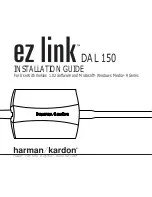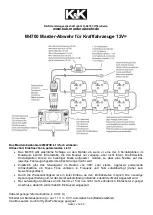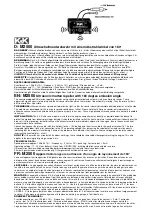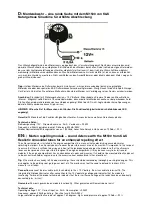
User Information Guide – Protective Helmets for Structural Firefighting
Pre-use Information
General Construction and Features
–
Your EV1 protective helmet has been
manufactured to comply with NFPA
1971,
Standard on Protective Ensembles
for Structural Fire Fighting and Proximity
Fire Fighting
. Honeywell offers two styles
of this helmet: a traditional style (HT-
TRA- EV1) and a modern style (HT-MOD-
EV1). Each type of structural firefighting
protective helmet consists of a shell,
suspension system, retention system,
and ear covers and is provided with an
integrated eye protection component (EZ
Touch). These helmets also have high-
visibility markings on the shell and
include several options for additional
eye/face protection devices (goggles or
faceshield) and visibility markings. Other
optional features include various types of
fronts. Specific information about
designs, materials, and features of these
helmet styles is provided on the
Honeywell website at
www.honeywellfirstresponder.com.
Safety Considerations and
Limitations of Use
– It is critically
important that you do not use your EV1
protective helmet until you have read
and understood this entire guide and
the labels provided on the interior of
your protective helmet. In order to
reduce – but not eliminate – your risks,
do not wear this protective helmet
unless:
•
You Understand the Labels, this
Guide and Applicable Standards:
You have read, fully understand, and
strictly adhere to the following: this
guide and all labels for this helmet;
NFPA 1971,
Standard on Protective
Ensembles for Structural Fire Fighting
and Proximity Fire Fighting
; NFPA 1851,
Standard on Selection, Care, and
Maintenance of Protective Ensembles
for Structural Fire Fighting and
Proximity Fire Fighting
; and applicable
national, state/provincial, and local
regulations pertinent to emergency
operations in your area.
•
Your Use Is in Accordance with
Applicable Standards and Regula-
tions:
Your use of this protective
helmet is consistent with NFPA1500,
Standard on Fire Department
Occupational Safety and Health
Program
and with Title 29, Code of
Federal Regulations
Part 1910.132 and General
Requirements of Subpart I,
“Personal Protective Equipment.”
•
Need for Hazard/Risk
Assessment:
Your department,
organization, or employer has
conducted a hazard/risk
assessment and determined that
this helmet provides an acceptable
level of protection for the particular
emergency operations consistent
with applicable federal,
state/provincial, and local
regulations.
•
Your Helmet Is Properly Adjusted:
Your helmet must fit or be adjusted
to the size of your head. It also
should be positioned to not interfere
with your self-contained breathing
apparatus (SCBA) facepiece.
•
All Components of Your Helmet
Are in Place and Properly Worn:
Your helmet must be complete and
you must wear your helmet properly.
This includes the full deployment of
your ear covers and the proper
attachment and adjustment of your
chinstrap for securing the helmet on
your head.
•
Limitations of Protection:
You
have been trained and understand
that not all helmets provide heat
and/or flame resistance or protection
from all hazards, and you have been
trained and understand how to
select and properly use the
appropriate helmet to meet the
expected exposure.
•
Heat Stress:
Wearing your
protective helmet together with other
ensemble elements may increase
your risk of heat stress, which may
cause heart attack, stroke,
dehydration, or other health related
conditions. At the first sign of heat
stress, immediately seek medical
help.
•
Burn Injury:
Your protective helmet
will not protect you from all burns
and injuries. If your protective
helmet is exposed to radiant,
convective, or conductive heat, or
comes in contact with a hot
environment or hot object, you may
be burned underneath the protective
helmet with no warning and no sign
of damage to the protective helmet.
•
Heat Sensation:
Your protective
helmet will lower your ability to feel
heat. Do not be misled by the
absence of heat or discomfort
underneath your protective
• helmet. Even though you do not feel
heat or discomfort, you can be
burned or injured suddenly and
without warning. If you feel heat or
some slight discomfort or unusual
sensation under your protective
helmet, you may already have
been burned or are about to be
burned. Be constantly alert to the
possibility of exposure to heat and
other hazards.
•
Barrier Protection:
Your helmet’s
ear covers are NOT equipped with
barrier material. Consequently, your
protective helmet will provide little to
no integrity against liquids in your
head and face area. Your protective
helmet may not protect you from all
chemical, radiological, or biological
hazards that can cause death,
injuries, diseases, and illnesses.
Furthermore, this helmet does not
offer any protection from hazardous
vapors or gases, liquefied gases, or
cryogenic liquids. Ensure that you
have a proper interface for your
protective helmet with your
protective coat, protective hood, and
SCBA.
•
Other Hazards:
Your protective
helmet, wet or dry, may not offer
protection from electrical shock.
Your protective helmet will not
protect you from all physical
hazards. Heavy falling objects or
impact with hard surfaces involve
forces that can be fatal or severely
injure you. Do not use your
protective helmet if it is
contaminated, cut, punctured, worn,
cracked, abraded, or altered from its
original condition.
•
Need for Complete Ensemble:
This helmet is effective only when it
is properly worn; provides a proper
interface with your garment, hood,
and SCBA; and is part of a
complete ensemble. A complete
ensemble includes appropriate
elements for your overall protection
and is consistent with your
organization/department’s hazard/
risk assessment.
•
Proper Care and Maintenance:
This helmet must be properly
inspected, maintained, and cared for
by your department, organization, or
employer consistent with these
instructions and applicable federal,
state/provincial, and local
regulations. It must be free of
soiling, contamination, damage, and
any alteration from its original
condition that would compromise its
protection. Damage and
contamination of this helmet may


























